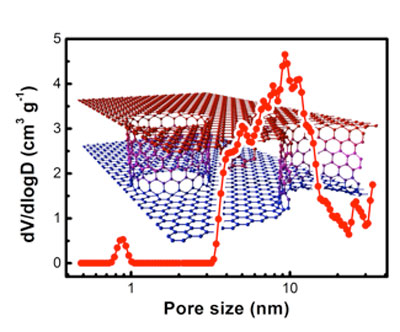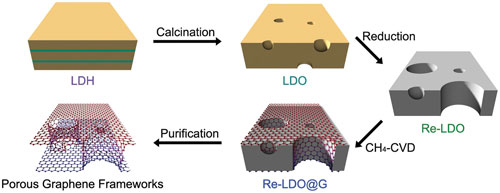| Posted: Oct 05, 2015 | |
3D graphene with high surface area and large mesopore volume |
|
| (Nanowerk Spotlight) The performance of batteries and supercapacitors depends on the density at which they can store energy and the speed at which they can be charged and discharged. These functions critically depend on the nanostructured electrodes that are used in these energy systems. | |
| Porous carbon nanomaterials are widely employed as electrodes for supercapacitors and electrodes in commercial lithium ion batteries. Porous carbon, such as activated carbon, microporous carbon, and mesoporous carbon, usually has very high surface area and tunable porous structure but very poor electrical conductivity. | |
| In contrast, sp2 carbon – graphene, fullerenes, and carbon nanotubes – exhibit high electrical conductivity but limited surface area. | |
| "A carbon material with high electrical conductivity, high specific surface area, tunable pore structure, mechanically robust framework, and high chemical stability is an important requirement for advanced electrochemical energy storage," Dr. Qiang Zhang, an associate professor at the Department of Chemical Engineering at Tsinghua University, tells Nanowerk. "However, neither porous carbon or sp2 carbon can full meet these requirements yet." | |
| How to create a conductive carbon material with especially large pore volume, and hence large surface area, has therefore been a key focus in electrode research. | |
| Recently, Zhang's group has succeeded in creating a novel 3D porous graphene framework (PGF) that inherits the hierarchical mesoporous structure of oxide templates. The as-obtained material possesses a high surface area of 1448 m2 g-1, 91.6% of which is contributed by mesopores, and a high mesopore volume of 2.40 cm3 g-1. | |
| The team reported their findings in Small ("3D Mesoporous Graphene: CVD Self-Assembly on Porous Oxide Templates and Applications in High-Stable Li-S Batteries"). | |
 |
|
| Illustration of 3D porous graphene frameworks with large mesopore volume. The pore size distribution of graphene frameworks is employd as the background. (Reprinted with permission by Wiley-VCH Verlag) | |
| The researchers fabricated the hierarchical metal oxide templates that they used from layered double hydroxide (LDH) precursors (Zn-Mg-A) through facile calcination and reduction. | |
| In fact, Zhang's lab has been working on LDHs for the past eight years, and they can easily modulate the nanostructures of metal oxides derived from the LDH precursors (see for instance: "Novel nanocarbon architecture makes a superior bifunctional electrocatalyst"). | |
| "In our new work, we propose an in situ route to fabricate hierarchically mesoporous oxide templates, in which small pores are introduced by Kirkendall diffusion during calcination of precursors and large pores are attributed to evaporation of volatile metal during subsequent reduction of Zn," Jia-Le Shi, a graduate student in Zhang's group and the paper's first author, explains. "When we subsequently employed these calcinated and reduced Zn-Mg-Al LDHs as templates for casting of graphene through chemical vapor deposition self-assembly, we obtained 3D graphene frameworks with an abundance of mesopores." | |
 |
|
| Schematic for PGF fabrication. A hierarchically porous oxide flake with small pores induced by Kirkendall diffusion during calcination and large pores attributed to volatile metal evaporation during subsequent reduction was used as a hard template to cast graphene. The PGF with large mesopores was obtained by chemical removal of the oxide template. (Reprinted with permission by Wiley-VCH Verlag) | |
| As a practical example, the team employed their as-obtained porous graphene frameworks as conductive scaffolds to host sulfur for lithium ion storage. | |
| It has already been demonstrated previously that the use of highly conductive carbon is an effective route to accommodate sulfur as a composite cathode for lithium ion storage (see our previous Nanowerk Spotlight: "Two-carbon marriage for better lithium-sulfur battery") | |
| "We filled 70% sulfur into the graphene framework and got a very high sulfur utilization of 71% and a very low fading rate of ∼0.04% per cycle after the second cycle at 1.0 C," notes Zhang. "The capacity was well preserved 80% over 500 cycles." | |
| "We attribute the excellent cycling stability and rate performance to the abundance of large mesopores for storage and confinement of sulfur/polysulfides," he concludes. "Our work also provides a general strategy of volatile-metal-induced mesopore construction with a view toward the design of hierarchical nanomaterials for promising applications in not only energy storage, but also catalysis, separation, drug delivery, and electrocatalysis." | |
 By
Michael
Berger
– Michael is author of three books by the Royal Society of Chemistry:
Nano-Society: Pushing the Boundaries of Technology,
Nanotechnology: The Future is Tiny, and
Nanoengineering: The Skills and Tools Making Technology Invisible
Copyright ©
Nanowerk LLC
By
Michael
Berger
– Michael is author of three books by the Royal Society of Chemistry:
Nano-Society: Pushing the Boundaries of Technology,
Nanotechnology: The Future is Tiny, and
Nanoengineering: The Skills and Tools Making Technology Invisible
Copyright ©
Nanowerk LLC
|
|
|
Become a Spotlight guest author! Join our large and growing group of guest contributors. Have you just published a scientific paper or have other exciting developments to share with the nanotechnology community? Here is how to publish on nanowerk.com. |
|
